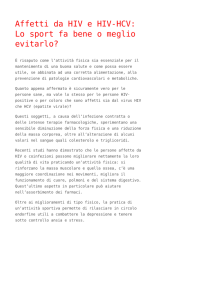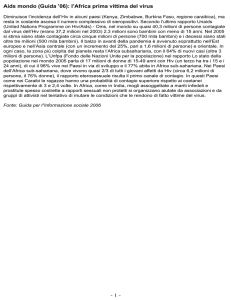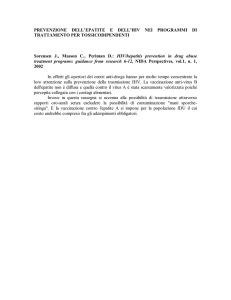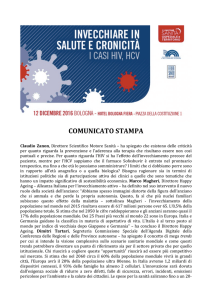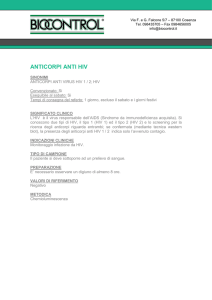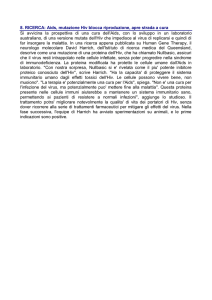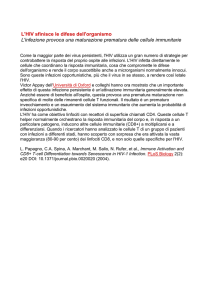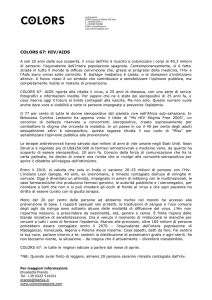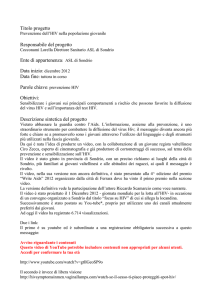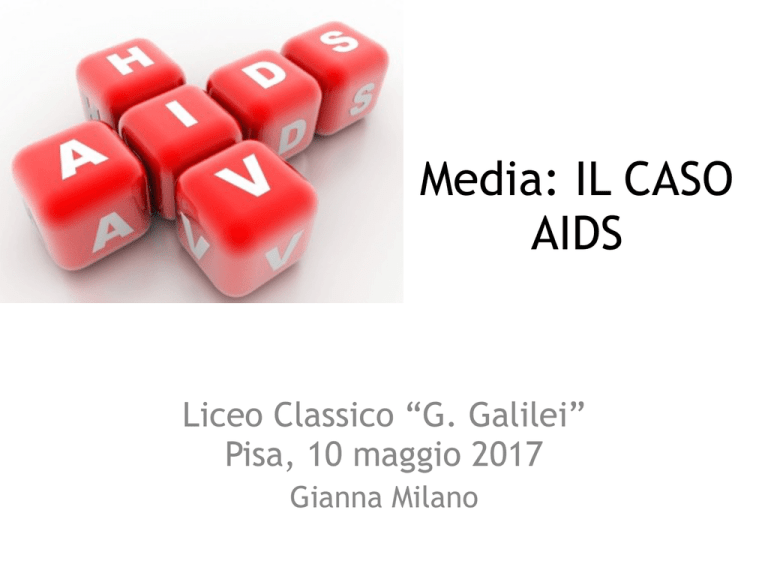
Media: IL CASO
AIDS
Liceo Classico “G. Galilei”
Pisa, 10 maggio 2017
Gianna Milano
Cronologia
- Nel 1981 viene riconosciuta l’esistenza di
una nuova malattia che in realtà esisteva
già da molti anni. Scambiata per altro.
- Nel 1982 alcuni primi casi tra gli
emofilici, obbligati a ricevere
trasfusioni di plasma.
- Nel 1983 i dati sull’infezione
Individuano 642 omosessuali,
154 tossicodipendenti, 50 haitiani
Il virus HIV
• Nel 1983 all’Istituto
Pasteur a Parigi i
ricercatori vedono il virus
al microscopio (Barré Sinoussi/Montagnier)
• L’anno dopo i CDC in Usa
annunciano di aver isolato
a loro volta il virus (Gallo).
• Il virus è lo stesso e inizia
una battaglia legale per la
rivendicazione della
scoperta.
I primi casi celebri
• A metà degli anni
Ottanta l’epidemia si
diffonde.
• Entra nella sua terza
fase: non è più solo
legata a gay, emofilici,
tossicodipendenti.
• Nel 1985 si tiene ad
Atlanta la prima
conferenza
internazionale
sull’AIDS.
AZT: la speranza
Nel 1987 a tempo di
record fu approvato un
primo farmaco, inibitore
della transcrittasi inversa,
per la cura dell’infezione.
Nel 1988 viene istituita la
Giornata mondiale
dell’AIDS: il 1 dicembre.
Manifestazioni alla
Conferenza Mondiale a
Montreal perché si abbassi
il prezzo di Azt.
“AIDS: se lo conosci lo eviti”
• Nel 1989 primi spot
pubblicitari in Italia per
informare sul rischio: si
insiste su
tossicodipendenti e
rapporti sessuali non
protetti.
• Nel 1990 alla Conferenza
internazionale a San
Francisco sull’AIDS
manifestazioni contro le
norme restrittive di G.W.
Bush per i sieropositivi.
La svolta
• Nel 1996 la svolta: si
abbandona la monoterapia
con Azt: nuovi studi clinici
dimostrano l’efficacia
della Haart (Highly Active
Antiretroviral Therapy) che
combina due inibitori della
transcrittasi inversa con un
inibitore della proteasi. La
triterapia diventa standard
mondiale per la cura
dell’Aids. (David Ho)
The Agreement on Trade Related
Aspects of Intellectual Property
Rights
80%
Impatto dell’Aids sulla speranza di vita
alla nascita in Africa.
Prevalenza stimata di Hiv nei giovani adulti (15-19
anni)
per nazione
In Italia: le infezioni non si fermano
• Dati dell’Istituto Superiore di Sanità dicono
che, nel 2015, sono state segnalate 3.444
nuove diagnosi di infezione da Hiv: pari a 5,7
nuovi casi per 100.000 residenti. I casi di Aids
registrati 789.
• L’Italia è per incidenza al tredicesimo posto
tra le nazioni dell’UE. Le regioni con
l’incidenza più alta sono Lazio, Lombardia
(20mila persone sieropositive), Liguria, EmiliaRomagna.
E ancora…..
• Le persone che hanno scoperto di avere l’Hiv
nel 2015 erano maschi nel 77,4% dei casi.
• L’età mediana 39 anni per lui e 36 anni per lei.
• L’incidenza più alta è tra le persone di 25-29
anni.
• La modalità di trasmissione: aumentano i casi
attribuibili a rapporti sessuali non protetti
• Nel 2015 i casi attribuiti a trasmissione
eterosessuale sono stati il 44,9 %.
Sieropositivo ma
non sa di esserlo
Si stima che nel
mondo solo la metà
delle persone con
Hiv sanno di essere
sieropositiva.
In Italia il 25 per
cento delle
persone con
l’infezione da Hiv è
consapevole del
proprio stato
La Stampa, 6 marzo 2016
Titolo
“Quei malati fantasma di Hiv: in Italia il
virus silenzioso contagia 11 persone al
giorno”
Sommario
Quattro sieropositivi su dieci lo nascondono
ai familiari, il 5% al partner. Quasi uno su tre
è immigrato. E adesso arriva il primo piano
nazionale anti-Aids
Grazie per la vostra
attenzione
AIDS related deaths
▪ AIDS-related deaths have fallen by 45% since the
peak in 2005.
In 2015, 1.1 million [940 000–1.3 million] people
died from AIDS-related causes worldwide, compared
to 2 million [1.7 million–2.3 million] in 2005.
▪ Tuberculosis-related deaths among people living
with HIV have fallen by 32% since 2004.
• Tuberculosis remains the leading cause of death
among people living with HIV, accounting for around
one in three AIDS-related deaths.
• In 2014, the percentage of identified HIV-positive
tuberculosis patients who started or continued on
antiretroviral therapy reached 77%.
REGIONAL STATISTICS—2015
• Asia and the Pacific
– In 2015, there were 5.1 million [4.4 million–5.9 million] people living with
HIV.
– In 2015, there were an estimated 300 000 [240 000–380 000] new HIV
infections in the region.
– New HIV infections declined by 5% between 2010 and 2015.
180 000 [150 000–220 000] people died of AIDS-related causes in 2015.
– Between 2010 and 2015, the number of AIDS-related deaths in the
region decreased by 24%.
– Treatment coverage was 41% [35–47%] of all people living with HIV.
– An estimated 3 million [2.3 million–3.8 million] adults did not have
access to antiretroviral therapy in Asia and the Pacific in 2015.
– There were 19 000 [16 000–22 000] new HIV infections among children
in Asia and the Pacific in 2015.
– Since 2010, there has been a 26% decline in new HIV infections among
children in the region.
East and southern Africa
• In 2015, there were 19 million [17.7 million–20.5
million] people living with HIV in eastern and southern
Africa.
• Women account for more than half the total number of
people living with HIV.
• In 2015, there were an estimated 960 000 [830 000–1.1
million] new HIV infections.
• New HIV infections declined by 14% between 2010 and
2015.
• Eastern and southern Africa accounts for 46% of the
global total of new HIV infections.
• In eastern and southern Africa, 470 000 [390 000–560
000] people died of AIDS-related causes in 2015.
• Between 2010 and 2015, the number of AIDS-related
deaths fell by 38%.
East and southern Africa
• In eastern and southern Africa, 10.3 million
people were accessing antiretroviral therapy, 54%
[50–58%] of all people living with HIV in the region.
• 59% [55–64%] of adult women (aged 15 years and
over) and 44% [41–48%] of adult men were
accessing antiretroviral therapy in 2015.
• Six out of 10 people on antiretroviral therapy live
in eastern and southern Africa.
• There were 56 000 [40 000–76 000] new HIV
infections among children in eastern andsouthern
Africa in 2015.
• Since 2010, there has been a 66% decline in new
HIV infections among children in the region.
Eastern Europe and central Asia • In 2015, there were 1.5 million [1.4 million–1.7 million]
people living with HIV in eastern Europe and central
Asia.
• In 2015, there were an estimated 190 000 [170 000–200
000] new HIV infections in the region.
• New HIV infections rose by 57% between 2010 and 2015.
• In eastern Europe and central Asia, 47 000 [39 000–55
000] people died of AIDS- related causes in 2015.
• Between 2010 and 2015, the number of AIDS-related
deaths in the region increased by 22%.
• Treatment coverage is 21% [20–23%] of all people living
with HIV in eastern Europe and central Asia.
• There were <1000 [<1000–1100] new HIV infections
among children in the region in 2015.
Latin America and the Caribbean ▪ In 2015, there were 2 million [1.7 million–2.3 million]
people living with HIV in Latin America.
▪ In 2015, there were an estimated 100 000 [86 000–120
000] new HIV infections in the region.
• The number of new HIV infections did not vary between
2010 and 2015.
In Latin America, 50 000 [41 000–59 000] people died of
AIDS-related causes in 2015.
• Between 2010 and 2015, the number of AIDS-related
deaths in the region fell by 18%.
• Treatment coverage in 2015 was 55% [47–64%] among all
people living with HIV in Latin America.
• There were 2100 [1600–2900] new HIV infections among
children in Latin America in 2015.
Middle East and North Africa • In 2015, there were 230 000 [160 000–330 000] people
living with HIV .
• In 2015, there were an estimated 21 000 [12 000–37 000]
new HIV infections in the region.
• New HIV infections rose by 4% between 2010 and 2015.
And 12 000 [8700–16 000] people died of AIDS-related
causes in 2015.
• Between 2010 and 2015, the number of AIDS-related
deaths in the region increased by 22%.
• Treatment coverage in 2015 was 17% [12–24%] among
people living with HIV i.
• There were 2100 [1400–3200] new HIV infections among
children in the Middle East and North Africa in 2015.
Western and central Africa •
•
•
•
•
•
•
•
In 2015, there were 6.5 million [5.3 million–7.8 million] people
living with HIV in western and central Africa.
Women account for nearly 60% of the total number of people living
with HIV.
In 2015, there were an estimated 410 000 [310 000–530 000] new
HIV infections .
New HIV infections declined by 8% between 2010 and 2015.
In western and central Africa, 330 000 [250 000–430 000] people
died of AIDS-related causes in 2015.
Between 2010 and 2015, the number of AIDS-related deaths in
western and central Africa fell by 10%.
In western and central Africa, 1.8 million people were accessing
antiretroviral therapy, 28% [23–34%] of all people living with HIV in
the region.
There were 66 000 [47 000–87 000] new HIV infections among
children in western and central Africa in 2015.
Since 2010, there has been a 31% decline in new HIV infections
among children in the region.
Western and central Europe and North America • In 2015, there were 2.4 million [2.2 million–
2.7 million] people living with HIV in western
and central Europe and North America.
• In 2015, there were an estimated 91 000 [89
000–97 000] new HIV infections in the region.
• In western and central Europe and North
America, 22 000 [20 000–24 000] people died
of AIDS-related causes in 2015.
• Between 2010 and 2015, the number of AIDSrelated deaths in the region decreased by 24%.

